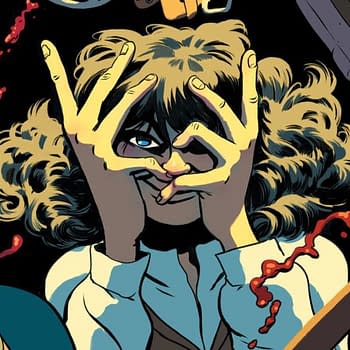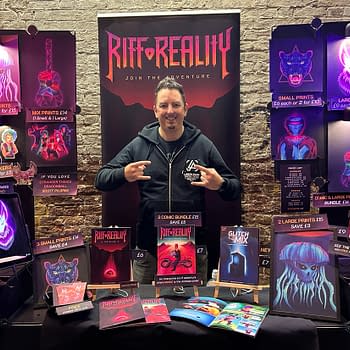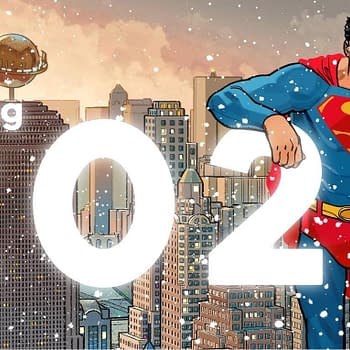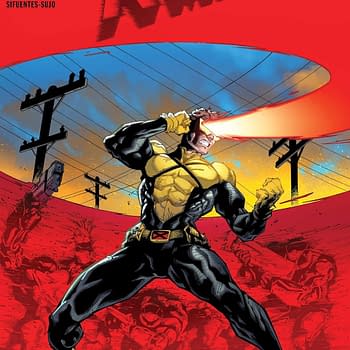Posted in: Comics | Tagged: Comics, damsels, dynamite
Damsels: Mermaids #1 Commentary By Matt Sturges
Matt Sturges writes a commentary on Damsels: Mermaid #1, out yesterday;
Page One
For readers raised on other versions of the character, the Little Mermaid depicted here might be a bit shocking. The Hans Christian Anderson fairytale "The Little Mermaid" resembles its 20th century animated adaptation about as much as you might imagine a middle school production of Scarface would resemble the Brian de Palma film.
In the original, the Little Mermaid doesn't marry her prince aboard a galleon. She refuses to murder her prince in order to exact her revenge and thus dies and turns into seafoam. Neither was appropriate for the storytelling purposes of Damsels: Mermaids, however, so we split the differences. Here, she does not die and turn into seafoam, but she also does not marry her prince. And that has left her in a bad way, as we'll see.
Note that all of the place names I used in the story, such as Thuvaraiyam Pathi, are "actual" places, in that they exist in some mythological geography. Thuvaraiyam Pathi, for instance, is a mythological sunken city in Ayyavazhi mythology. But you knew that.
Page Two
Somewhere in a scriptwriting book I read once, they advise you to "Save the cat." That means that if you want people to like your character, have them save a cat, or otherwise do something generous and kind-hearted. It's sound advice, if a bit hackish. Here, though, it's important because it lets us know that she's not only brave and generous, but also rather reckless as well.
Cats can't swim, of course, which is why LM has to save a baby seal instead. Because there's nothing manipulative about the cuteness of baby seals. Not at all.
Pages Four and Five
Sharks! When I pitched this series I promised that it would have sharks, pirates, and sea monsters. Sharks: check. Take a moment to enjoy that lovely coloring effect. Isn't that nice?
"Siobhán," of course, is Irish because in my mind all selkies are Irish due to the excellent movie The Secret of Roan Inish. In case you're wondering, the name is pronounced Sha-VAUN. Siobhán the Selkie here warns readers that perhaps LM is feeling a bit sorry for herself and perhaps needs to lighten up. Siobhán is a shallow creature with shallow needs, and it doesn't take much for her to be happy.
Page Eight
Selkies don't know what ashes are. You might think so, since they have been known to slip out of the water and join unsuspecting Irishmen at their campfires, but they never stick around until the fire dies.
Page Nine
Here LM states the essential theme of the book, which is good because otherwise she's pretty much just sitting on a rock all night without moving.
Page Ten
And a handsome young man is exiled on LM's little island! For some reason, all fairy tales happened right around the Napoleonic era. It's hard to put your finger on, but if you look at the technology, art, and clothing of just about any fairy tale depiction, it seems to be happening at the close of the 18th century. Why? Nobody knows. Don't ask. Just enjoy the tricorn hats. (Although if I had to guess it's because the Grimms were published in 1812, and Hans Christian Anderson in 1835.)
Page Thirteen
John here is singing from "Fair Rosamond," a medieval ballad of which Sir Walter Scott heartily approved. It tells the story of King Henry II's mistress, the titular Rosamond, who is poisoned by a jealous queen Eleanor. In medieval ballads, the mistress was the good guy.
Page Fourteen
At last we get the lay of the land. John is a prince of Avalon! You couldn't have a story worthy of the name Damsels without a prince in there somewhere, right? But can we trust this Prince John? Can we?
Between pages 15 and 16 is an ad for Red Sonja, written by Gail Simone. I just want to take a minute out of commenting on Damsels: Mermaids to encourage you to pick that one up, because it's probably going to be pretty darn good. Now, where were we?
Page Sixteen
Hey, he called her "little mermaid." That's what we call her!
Here's why the Little Mermaid has no name in my story: In the original fairy tale, Hans Christian Anderson never sees fit to give her one. He only refers to her as "little mermaid," not because she's small but because she's the youngest of six girls. In one rather popular cinematic representation of the story, she's given the name "Ariel." I couldn't call her that because that was their idea, and anyway "Ariel" is the name of Prospero's daughter in The Tempest, which has no thematic connection to this story, and literally means "Lion of God," which also makes no sense, as the whole point of Anderson's story was that fish-people don't have souls.
Anyway, I tried coming up with different names for her, but none fit. Using my always-successful tactic of "give the problem to the story" I declared that she had no name because it had been stripped of her. Problem solved!
Page Seventeen
All of this information about seagulls is true, by the way. So if you want to try fried seagull, just look for one that appears peckish. But don't come crying to me when the SPCA comes knocking. I'll deny all knowledge of you.
Page Eighteen
Port Elysium! How can you possibly have a story that contains pirates without a seaside town filled with inns and intrigue? Answer: you can't! So don't try!
Why is the inn called the Crab and Pipe? If you don't know, I can't help you. But maybe watching this video might.
[youtube]http://www.youtube.com/watch?v=Wv14vZx6jvU[/youtube]
Page Twenty
And here is your official pirate for the series, Captain Argent. I'll warn you: he's not entirely what he seems. But you knew that already, right? I mean, right? Why's he named Argent? Should be pretty obvious, if you think about it for a minute.
Page Twenty-One
"Trust is overrated. I'll take a loaded pistol over trust any day of the week." That's Argent's philosophy. Should it be ours as well? By the end of the series we should see a few different characters' attempts to answer this question.
Page Twenty-Two
Atlantis! Very much not underwater! And filled with evil Hieromancers! "Hieromancer" is a word I made up that comes from Greek hiero "priestly" + manteia "divination." In other words, the leaders of Atlantis are magic-using priests. A dangerous combo.
Who's Vodyanoy? Don't google him or you'll spoil a scene from issue 2!





















